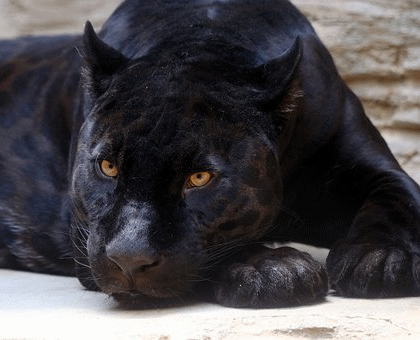
Black panther
Overview
Melanism
Melanism is an undue development of dark-colored pigment in the skin or its appendages, and the opposite of albinism. It is also the medical term for black jaundice.The word is deduced from the , meaning black pigment....
color variant of any of several species
Species
In biology, a species is one of the basic units of biological classification and a taxonomic rank. A species is often defined as a group of organisms capable of interbreeding and producing fertile offspring. While in many cases this definition is adequate, more precise or differing measures are...
of larger cat
Cat
The cat , also known as the domestic cat or housecat to distinguish it from other felids and felines, is a small, usually furry, domesticated, carnivorous mammal that is valued by humans for its companionship and for its ability to hunt vermin and household pests...
. Wild black panthers in Latin America are black jaguar
Jaguar
The jaguar is a big cat, a feline in the Panthera genus, and is the only Panthera species found in the Americas. The jaguar is the third-largest feline after the tiger and the lion, and the largest in the Western Hemisphere. The jaguar's present range extends from Southern United States and Mexico...
s (Panthera onca), in Asia and Africa they are black leopard
Leopard
The leopard , Panthera pardus, is a member of the Felidae family and the smallest of the four "big cats" in the genus Panthera, the other three being the tiger, lion, and jaguar. The leopard was once distributed across eastern and southern Asia and Africa, from Siberia to South Africa, but its...
s (Panthera pardus), and in North America they may be black jaguars or possibly black cougars (Puma concolor – although this has not been proven to have a black variant), or smaller cats.
Black panthers are also reported as cryptid
Cryptid
In cryptozoology and sometimes in cryptobotany, a cryptid is a creature or plant whose existence has been suggested but is unrecognized by scientific consensus and often regarded as highly unlikely. Famous examples include the Yeti in the Himalayas and the Loch Ness Monster in...
s in areas such as the United States and the United Kingdom, and if these do exist, their species is not known.
Unanswered Questions
Discussions

